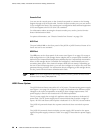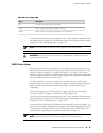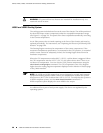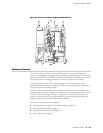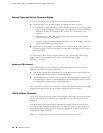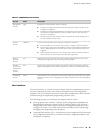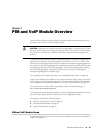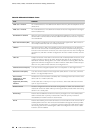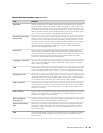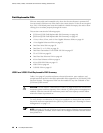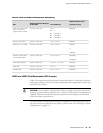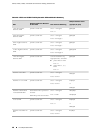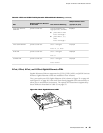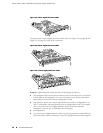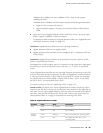
Table 18: PIM and VoIP Module Terms
DefinitionTerm
ITU-T Standard G.992.1 that defines how ADSL works over plain old telephone service
(POTS) lines.
ADSL 2/2+ Annex A
ITU-T Standard G.992.1 that defines how ADSL works over Integrated Services Digital
Network (ISDN) lines.
ADSL 2/2+ Annex B
ISDN cost-control feature defining the bandwidth threshold that must be reached on
all links before a Services Router initiates additional ISDN data connections to provide
more bandwidth.
bandwidth on demand
ISDN interface intended for home and small enterprise applications. BRI consists of
two 64-Kbps B-channels and one 16-Kbps D-channel.
Basic Rate Interface (BRI)
Alternative feature to dial-in that enables a J-series Services Router to call back the
caller from the remote end of a backup ISDN connection. Instead of accepting a call
from the remote end of the connection, the router rejects the call, waits a configured
period of time, and calls a number configured on the router's dialer interface. See also
dial-in.
callback
Telephone number of the caller on the remote end of a backup ISDN connection, used
to dial in and also to identify the caller. Multiple caller IDs can be configured on an
ISDN dialer interface. During dial-in, the router matches the incoming call's caller ID
against the caller IDs configured on its dialer interfaces. Each dialer interface accepts
calls from only callers whose caller IDs are configured on it.
caller ID
Unit that connects a digital telephone line to a multiplexer or other signal service.channel service unit (CSU)
Unit that connects a data terminal equipment (DTE) device—in this case, a Services
Router—to a digital telephone line.
data service unit (DSU)
Interface that a Services Router (the DTE) uses to exchange information with a serial
device such as a modem (the DCE).
A DTE cable uses a male 9-pin or 25-pin connector, and a DCE cable uses a female
9-pin or 25-pin connector.
data terminal
equipment–to–data
communication
equipment (DTE–DCE)
interface
Interface configured for dial-on-demand routing backup. In OSPF, the demand circuit
reduces the amount of OSPF traffic by removing all OSPF protocols when the routing
domain is in a steady state.
demand circuit
Feature that reestablishes network connectivity through one or more backup ISDN
dialer interfaces after a primary interface fails. When the primary interface is
reestablished, the ISDN interface is disconnected.
dial backup
Feature that enables J-series Services Routers to receive calls from the remote end of
a backup ISDN connection. The remote end of the ISDN call might be a service provider,
a corporate central location, or a customer premises equipment (CPE) branch office.
All incoming calls can be verified against caller IDs configured on the router's dialer
interface. See also callback.
dial-in
44 ■ PIM and VoIP Module Terms
J2320, J2350, J4350, and J6350 Services Router Getting Started Guide



